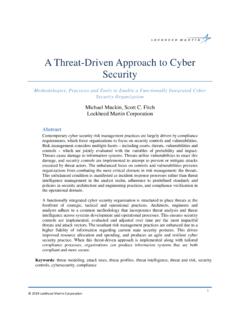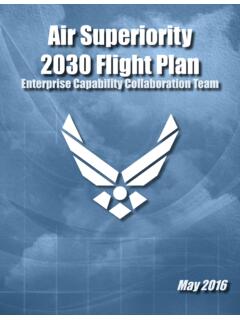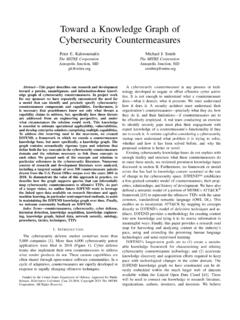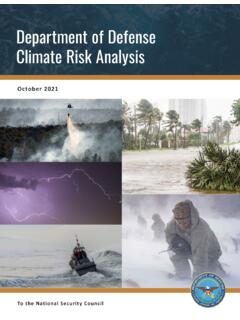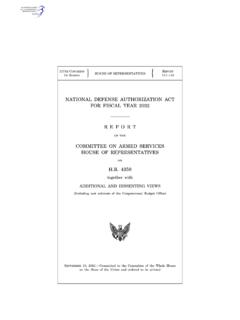Transcription of This publication is available at Army Knowledge Online To ...
1 This publication is available at Army Knowledge Online ( ). To receive publishing updates, please subscribe at TC 7-102 Training Circular No. 7- 102 Headquarters Department of the Army Washington, DC, 26 November 2014 Operational Environment and Army Learning Contents Page v INTRODUCTION .. vi Chapter 1 21ST CENTURY STRATEGIC ENVIRONMENT .. 1-1 Strategic Environment Awareness .. 1-1 Operational Environment Analysis .. 1-3 Chapter 2 THE ADDIE PROCESS .. 2-1 Section I - Analysis .. 2-4 Needs Analysis .. 2-7 Mission Analysis .. 2-7 Outcomes Analysis .. 2-8 Section II - Design .. 2-8 Individual Design Requirements .. 2-9 Collective Design Requirements .. 2- 11 Resource and Milestone Planning .. 2- 11 Section III - Development .. 2- 11 Conditions, Circumstances, and Influences .. 2- 13 Resource Analysis Considerations.
2 2- 14 Section IV - Implementation .. 2- 15 Management Implementation Requirements .. 2- 16 Core Implementation Requirements .. 2- 17 Section V - Evaluation .. 2- 18 Chapter 3 OPERATIONAL ENVIRONMENT ENTERPRISE SUPPORT .. 3-1 Operational Environment Enterprise .. 3-1 Operational Environment Enterprise Resources .. 3-2 Appendix A OE INTEGRATION JOB AID FOR ARMY LEARNING MODEL .. A-1 Appendix B EXERCISE DESIGN CHECKLIST .. B-1 Appendix C OPFOR tactical TASK LIST .. C-1 GLOSSARY .. Glossary-1 Distribution Restriction: Approved for public release; distribution is unlimited. i Contents REFERENCES .. References-2 Required Publications .. 2 Related Publications .. 2 Recommended Readings .. 3 Web Sites .. 3 Prescribed Forms .. 3 Referenced Forms .. 3 INDEX .. Index-1 Figures Figure 1. OEE products-services-support to Army learning experiences (examples).
3 Vi Figure 2. The Army mission .. vii Figure 1-1. Operational environment definition .. 1-1 Figure 1-2. Warfighting functions and elements of combat power .. 1-3 Figure 2-1. ADDIE training-education-leader development continuum .. 2-1 Figure 2-2. Training and education implication for Army readiness .. 2-2 Figure 2-3. Cyber gap introduction (example) .. 2-3 Figure 2-4. Analysis phase of ADDIE and OEE considerations .. 2-5 Figure 2-5. Cyber gap vignette-Analysis (example) .. 2-6 Figure 2-6. Design phase of ADDIE and OEE 2-8 Figure 2-7. Cyber gap vignette-Design (example) .. 2-9 Figure 2-8. Cyber gap vignette-Development (example) .. 2- 12 Figure 2-9. Development phase of ADDIE and OEE considerations .. 2- 13 Figure 2-10. Implementation phase of ADDIE and OEE considerations .. 2- 16 Figure 2-11.
4 Cyber gap vignette Implementation (example).. 2- 17 Figure 2-12. Evaluation phases of ADDIE and OEE considerations .. 2- 18 Figure 2-13. Cyber gap vignette-Evaluation (example) .. 2- 20 Figure 3-1. OEE support and Decisive Action Training Environment .. 3-4 Figure 3-2. OEE support and Regionally Aligned Force Training Environment .. 3-5 Figure 3-3. ARCIC and OEE support for cyber training requirement (example) .. 3- 14 Tables Table 1-1. Operational variables and subvariables (2014) .. 1-6 Table 2-1. Learning objective requirements .. 2- 10 Table 2-2. Political subvariable setting considerations (example) .. 2- 14 Table 2-3. Training and education resource considerations (example) .. 2- 15 Table A-1. OE considerations in the analysis phase (ADDIE) .. A-1 Table A-2. OE considerations in the design phase (ADDIE).
5 A-2 Table A-3. OE considerations of development phase (ADDIE) .. A-3 Table A-4. OE considerations in the implementation phase (ADDIE) .. A-3 ii TC 7-102 26 November 2014 Contents Table A-5. OE considerations for the evaluation phase (ADDIE) ..A-4 Table B-1. Exercise design checklist ..B-1 26 November 2014 TC 7-102 iii Contents This page intentionally left blank. iv TC 7-102 26 November 2014 Preface Training Circular (TC) 7-102 presents concise and enduring doctrine-based guidance on how to integrate the variables of an operational environment (OE) into Army training, education, and leader development. This TC includes concepts and capabilities (products, services, and support) developed for the Army as an Operational Environment Enterprise (OEE) to improve and sustain Army readiness.
6 The principal audience for TC 7-102 is all members of the profession of arms. The training and curriculum developer and the commander or leader responsible and accountable for developing and instituting the Army Learning Model (ALM), as referenced in AR 350-1, use this training circular. Commanders, staffs, and subordinates ensure that their decisions and actions comply with the applicable United States, international, and in some cases host-nation laws and regulations. Commanders at all levels ensure that their Soldiers operate in accordance with the law of war and the rules of engagement. (See FM 27-10.) For defin itions shown in the text, the term is italicized and the number of the proponent publication follows the definition. This publication is not the proponent for any Army terms.
7 TC 7-102 applies to the Active Army, the Army National Guard (ARNG)/Army National Guard of the United States (ARNGUS), and the United States Army Reserve (USAR) unless otherwise stated. The proponent of TC 7-102 is Headquarters, Army Training and Doctrine Command (TRADOC). The preparing agency is the Complex Operational Environment and Threat Integration Directorate (CTID) of the TRADOC G-2 Intelligence Support Activity (TRISA) Threats. Send comments and recommendations on DA Form 2028 (Recommended Changes to Publications and Blank Forms) directly to Director, CTID at TRADOC G-2 Intelligence Support Activity Threats, ATTN: ATIN-T (TC 7-102), 803 Harrison Drive, Building 467, Room 15, Fort Leavenworth, KS 66027-1323. 26 November 2014 TC 7-102 v Introduction Introduction Training Circular (TC) 7-102, Operational Environment and Army Learning, is a practical guide on how to integrate the conditions of an operational environment (OE) into robust, relevant, and realistic training, professional education, and leader development experiences.
8 This TC presents critical design techniques and means that support the fundamental concepts of a continuously adaptive learner-centric model the Army Learning Model (ALM) for improved Army mastery to anticipate, understand, and adapt successfully to complex, uncertain, and/or ambiguous environments in decisive action. The purpose of this TC is to guide the training developer, curriculum developer, and leader or commander on how to integrate OE conditions that enhance self-development, leader development, and unit or activity readiness. The intent is to achieve and sustain adaptive Army readiness to standards. Learning experiences range from personal one-on-one instructor-student or mentor-mentee dialogue to technology-enabled simulations and operational mission or training feedback that replicate a particular set of OE conditions in a task/action, conditions, and standards format.
9 The Army s Operational Environment Enterprise (OEE) delivers OE products, services and support to its Soldiers, civilians, leaders, and supported and supporting stakeholders for readiness. The OEE projects from the institutional training domain, that is, the Army s institutional training and education system, and impacts the entire Army mission. (See figure1.) OPERATIONAL ADAPTABILITYDOTMLPFS ingle Portal to DigitalLearning SourcesVirtual SimulationsLive SimulationsConstructiveSimulationsMilita ry GamingTechnologiesSoldier-createdSocial NetworksMobile DeviceApplicationsUnit-Te a m-GroupExercisesBlended LearningTechniquesLearning HubAccessMentor-MenteeDialoguedL ModulesMobile Training TeamLearning InterfaceAssessments &EvaluationsHistorical ReportsArmy EthicComprehensiveFitnessArmy CultureProfessional Military EducationSelf-developmentInitiativesPers onal ExperiencesHome Station TrainingDeployments &Combat ExperiencesSpecial Project ResearchFunctionalTrainingConcepts & CapabilitiesDevelopmentOE Assessments &Foundational AnalysesThreat RepresentationSupportPMESII-PTServicesPr oductsSelf DevelopmentInstitutionalOperationalExper tiseFigure 1.
10 OEE products-services-support to Army learning experiences (examples) The Operational Environment Enterprise (OEE) is an integrated training environment (ITE) resource that leverages technology-enabled presentations and other information for individual and collective learning experiences and expertise, as well as Army concepts and capabilities development with robust, realistic, and relevant OE conditions. The support provided by the OEE reaches across all Army learning domains with vi TC 7-102 26 November 2014 Introduction repositories of historical documentation; current observations and lessons learned; projected capabilities requirements, development, and experiment information; and facilitates integrated live, virtual, constructive, and gaming (LVCG) environments.










